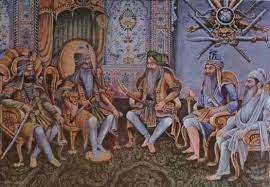Lineage Of Phulkian sardars:
The Jat rulers of the Phulkian states shared a common ancestor, the 18th-century Chaudhary Phul Singh. In Phul, a Chaudhary leader of the 18th century, the rulers of the Phulkian states shared a common ancestor. Chaudhary Phul was born in 1629, to Chaudhary Rup Chand and Mat Ambi. He lived through the times of Guru Hargobind Ji, the sixth guru of the Sikh religion as well as Guru Har Rai Ji , the seventh Guru. The legends of Phul say that Chaudhary Phul Singh was given blessings from both Guru Hargobind Ji and Guru Har Rai Ji. Guru Hargobind Ji declared that Phul would have many "blossoms" like a flower (Phul or "phool" is a Punjabi word for flower). Phul's descendants went on to pursue this blessing by ruling the states of Nabha, Jind, Faridkot, Kaithal and Patiala.
The Maharajas of all three Phulkian states had supported the pre-Raj East India Company during the Indian Rebellion of 1857, both with military forces and supplies, as well as by offering protection for European people in affected areas. Despite this, in 1858 the British Raj authorities rejected a petition to allow them to adopt heirs to ensure lines of succession. They believed that such processes could be dealt with on an ad hoc basis if and when the situation arose, and that to accept the petition would be contrary to the Doctrine of Lapse. The matter was eventually taken up by the government in Britain, who demanded that the Raj authorities should grant the petition in recognition of the considerable loyalty that had been demonstrated during the rebellion. Thus, on 19 January 1860 at a durbar in Ambala, Charles Canning, the Governor-General of India, acceded to the request.
The Jat rulers of the Phulkian states shared a common ancestor, the 18th-century Chaudhary Phul Singh. In Phul, a Chaudhary leader of the 18th century, the rulers of the Phulkian states shared a common ancestor. Chaudhary Phul was born in 1629, to Chaudhary Rup Chand and Mat Ambi. He lived through the times of Guru Hargobind Ji, the sixth guru of the Sikh religion as well as Guru Har Rai Ji , the seventh Guru. The legends of Phul say that Chaudhary Phul Singh was given blessings from both Guru Hargobind Ji and Guru Har Rai Ji. Guru Hargobind Ji declared that Phul would have many "blossoms" like a flower (Phul or "phool" is a Punjabi word for flower). Phul's descendants went on to pursue this blessing by ruling the states of Nabha, Jind, Faridkot, Kaithal and Patiala.
The Maharajas of all three Phulkian states had supported the pre-Raj East India Company during the Indian Rebellion of 1857, both with military forces and supplies, as well as by offering protection for European people in affected areas. Despite this, in 1858 the British Raj authorities rejected a petition to allow them to adopt heirs to ensure lines of succession. They believed that such processes could be dealt with on an ad hoc basis if and when the situation arose, and that to accept the petition would be contrary to the Doctrine of Lapse. The matter was eventually taken up by the government in Britain, who demanded that the Raj authorities should grant the petition in recognition of the considerable loyalty that had been demonstrated during the rebellion. Thus, on 19 January 1860 at a durbar in Ambala, Charles Canning, the Governor-General of India, acceded to the request.
Lineage Of Phulkian sardars:
The Jat rulers of the Phulkian states shared a common ancestor, the 18th-century Chaudhary Phul Singh. In Phul, a Chaudhary leader of the 18th century, the rulers of the Phulkian states shared a common ancestor. Chaudhary Phul was born in 1629, to Chaudhary Rup Chand and Mat Ambi. He lived through the times of Guru Hargobind Ji, the sixth guru of the Sikh religion as well as Guru Har Rai Ji , the seventh Guru. The legends of Phul say that Chaudhary Phul Singh was given blessings from both Guru Hargobind Ji and Guru Har Rai Ji. Guru Hargobind Ji declared that Phul would have many "blossoms" like a flower (Phul or "phool" is a Punjabi word for flower). Phul's descendants went on to pursue this blessing by ruling the states of Nabha, Jind, Faridkot, Kaithal and Patiala.
The Maharajas of all three Phulkian states had supported the pre-Raj East India Company during the Indian Rebellion of 1857, both with military forces and supplies, as well as by offering protection for European people in affected areas. Despite this, in 1858 the British Raj authorities rejected a petition to allow them to adopt heirs to ensure lines of succession. They believed that such processes could be dealt with on an ad hoc basis if and when the situation arose, and that to accept the petition would be contrary to the Doctrine of Lapse. The matter was eventually taken up by the government in Britain, who demanded that the Raj authorities should grant the petition in recognition of the considerable loyalty that had been demonstrated during the rebellion. Thus, on 19 January 1860 at a durbar in Ambala, Charles Canning, the Governor-General of India, acceded to the request.
0 Commenti
0 condivisioni
0 Anteprima




